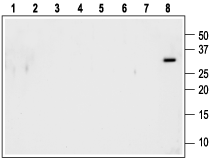Overview
- Peptide (C)DTELLRQQRRYNSPR, corresponding to amino acid residues 89-103 of human NT-3 (precursor) (Accession P20783). Pro-domain of the NT-3 protein.

 Western blot analysis using Anti-proNT-3 Antibody (#ANT-012) (1:600):1. Recombinant human Neurotrophin-3 (NT-3) protein (#N-260), (200 ng).
Western blot analysis using Anti-proNT-3 Antibody (#ANT-012) (1:600):1. Recombinant human Neurotrophin-3 (NT-3) protein (#N-260), (200 ng).
2. Recombinant human Neurotrophin-4 (NT-4) protein (#N-270), (200 ng).
3. Native mouse NGF 2.5S protein (>95%) (#N-100), (200 ng).
4. Recombinant human beta-NGF protein (#N-245), (200 ng).
5. Recombinant human BDNF protein (#B-250), (200 ng).
6. Recombinant mouse proNGF protein (#N-250), (200 ng).
7. Recombinant mouse proBDNF protein (#B-240), (200 ng).
8. Recombinant proNT-3, (10 ng). Western blot analysis of mouse recombinant proNT-3:1,5. 10 ng proNT-3.
Western blot analysis of mouse recombinant proNT-3:1,5. 10 ng proNT-3.
2,6. 50 ng proNT-3.
3,7. 100 ng proNT-3.
4,8. 200 ng proNT-3.
Lanes 1-4 Anti-proNT-3 Antibody (#ANT-012), (1:300).
Lanes 5-8 Anti-proNT-3 Antibody, preincubated with proNT-3 Blocking Peptide (#BLP-NT012).
 Expression of proNT-3 in rat brainImmunohistochemical staining of rat Islands of Calleja (IOC) using Anti-proNT-3 Antibody (#ANT-012). A. proNT-3 staining (green) overlaps neuronal nitric oxide synthase (nNOS red) while a cluster of cells covers a part of the island (DAPI blue counterstain) but not a cell-poor area (star). B. The distribution of proNT-3 is shown alone. Note that staining is more intense in the cell poor area demarcated by white line. C. The distribution of neuronal NOS is most intense in the cell-poor region.
Expression of proNT-3 in rat brainImmunohistochemical staining of rat Islands of Calleja (IOC) using Anti-proNT-3 Antibody (#ANT-012). A. proNT-3 staining (green) overlaps neuronal nitric oxide synthase (nNOS red) while a cluster of cells covers a part of the island (DAPI blue counterstain) but not a cell-poor area (star). B. The distribution of proNT-3 is shown alone. Note that staining is more intense in the cell poor area demarcated by white line. C. The distribution of neuronal NOS is most intense in the cell-poor region.
- Hempstead, B. (2002) Curr. Opin. Neurobiol. 12, 260.
- Blum, R. and Konnerth, A. (2005) Physiology 20, 70.
Brain derived neurotrophic factor (BDNF) is a member of the neurotrophin family of growth factors that includes nerve growth factor (NGF), neurotrophin-3 (NT-3) and neurotrophin-4/5 (NT-4/5).
All neurotrophins are synthesized as preproneurotrophin precursors that are subsequently processed within the intracellular transport pathway to yield proneurotrophins. These are further processed to generate the mature form. The mature form of BDNF is a non-covalent stable homodimer that can be secreted in both constitutive and regulated pathways.
Until recently, the functional role of the neurotrophin prodomain was thought to assist in the correct folding of the mature protein and the sorting of the neurotrophin into the constitutive or regulated secretory pathway. However, a growing body of evidence suggests that the uncleaved proneurotrophin precursors can be secreted from cells and that they may mediate different biological functions. Several studies implicate both proNGF and proBDNF in several physiological and pathological conditions.
It remains to be established whether proNT-3 has different biological functions than the mature NT-3 neurotrophin.
Application key:
Species reactivity key:
Alomone Labs is pleased to offer a highly specific antibody directed against an epitope of human proNT-3. Anti-proNT-3 Antibody (#ANT-012) can be used in western blot and immunohistochemistry applications. It has been designed to recognize proNT-3 from rat, mouse and human samples. The antibody does not cross reacts with mature NT-3, pro- and mature NGF or pro- and mature BDNF.
